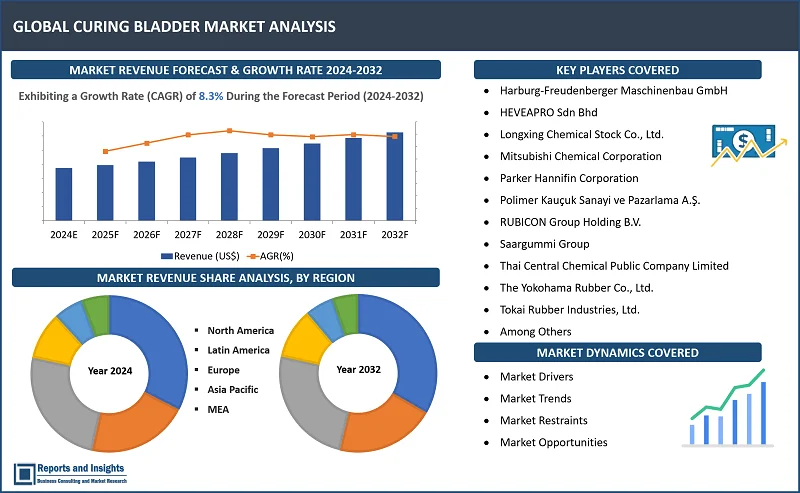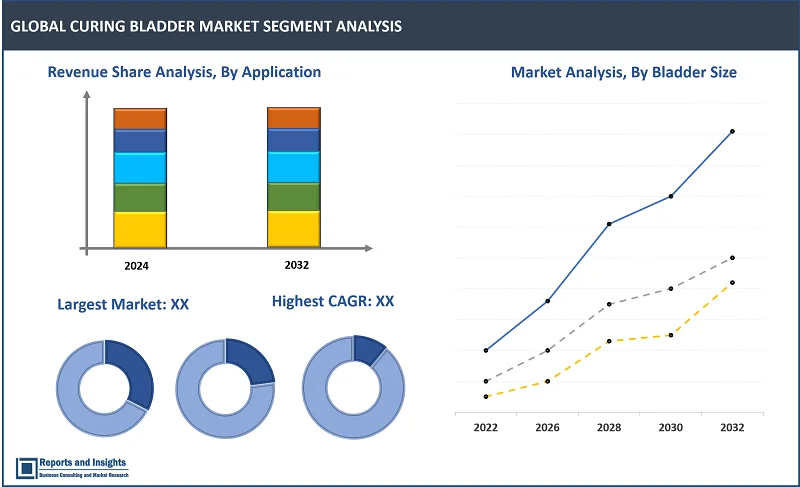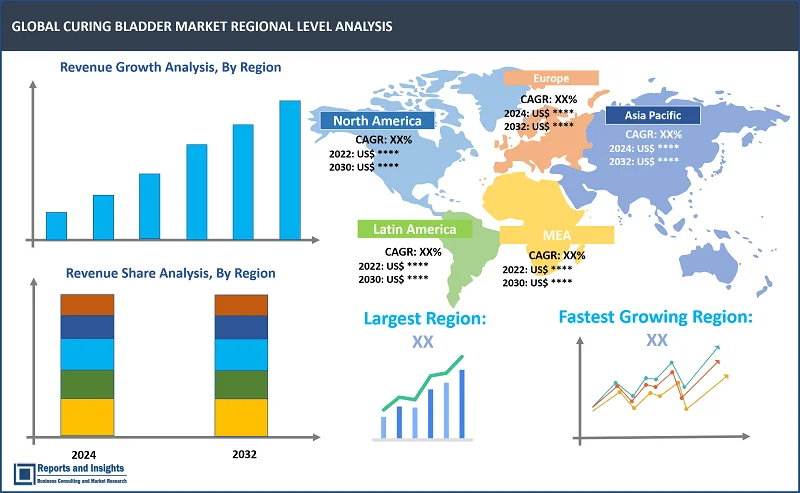Market Overview:
"The global curing bladder market size reached US$ 1.3 billion in 2023. Looking forward, Reports and Insights expects the market to reach US$ 2.7 billion in 2032, exhibiting a growth rate (CAGR) of 8.3% during 2024-2032."
|
Report Attributes |
Details |
|
Base Year |
2023 |
|
Forecast Years |
2024-2032 |
|
Historical Years |
2021-2023 |
|
Market Growth Rate (2024-2032) |
8.3% |
Curing bladder, also known as a tire curing bladder, is a critical component used in the tire manufacturing process. It is a flexible, inflatable rubber bladder that is placed inside the green tire during the curing phase. The bladder applies pressure and heat to mold the tire into its final shape while vulcanization takes place.
Curing bladders offer several benefits, such as ensuring uniform pressure distribution, resulting in improved tire quality, reduced defects, and enhanced durability. These products also facilitate efficient heat transfer, leading to faster curing cycles and increased productivity in tire production. Also, curing bladders help maintain consistent tire dimensions and sidewall aesthetics.
Different types of curing bladders are available in the market, including segmented, seamless, and multi-layered bladders. The appropriate type is selected based on specific tire curing requirements, such as tire size, design complexity, and desired performance characteristics.
The global curing bladder market is registering steady revenue growth due to the expanding automotive industry and rising demand for high-quality tires. Curing bladders are widely used in tire manufacturing processes. Manufacturers are focusing on providing advanced curing bladder services, such as customized designs and improved heat resistance, to cater to specific industry requirements.
Advancements in curing bladder technology, including the development of segmented and multi-layered bladders, have enhanced tire performance and efficiency. Initiatives to optimize curing processes and reduce curing defects are resulting in various innovations in this industry. The advantages of curing bladders include improved tire quality, increased productivity, and consistent tire dimensions.

Curing Bladder Market Trends and Drivers:
Increasing automotive production: Advancements and innovation in the global automotive industry directly impacts the curing bladders market demand. As automotive production continues to rise, the need for high-quality tires increases, thereby driving demand for curing bladders and positively impacting revenue growth in the market.
Advancements in curing bladder technology: Ongoing advancements in curing bladder technology have resulted in the development of more efficient and durable bladders. Advancements, such as segmented and multi-layered bladders, offer improved performance and increased productivity in tire manufacturing processes, leading to higher revenue growth in the global curing bladder market.
Focus on tire quality and durability: Tire manufacturers are placing a strong emphasis on tire quality and durability to meet consumer demands and regulatory standards. Curing bladders play a crucial role in achieving consistent tire dimensions, reducing defects, and enhancing tire performance. This focus on quality and durability drives the demand for curing bladders, contributing to revenue growth in the market.
Growing demand for customized curing bladder services: There is an increasing trend towards customized curing bladder services, where manufacturers offer tailored designs and improved heat resistance to meet specific industry requirements. This trend caters to the diverse needs of tire manufacturers and creates opportunities for revenue growth in the global curing bladder market.
Environmental initiatives and sustainable practices: The tire industry is witnessing a shift towards sustainable practices and environmental initiatives. Curing bladders that are more energy-efficient, recyclable, and environmentally friendly are gaining traction in the market. These sustainable alternatives positively impact revenue growth as tire manufacturers seek eco-friendly solutions for their production processes.
Curing Bladder Market Restraining Factors:
Volatility in raw material prices: The global curing bladder market is susceptible to fluctuations in prices of raw materials, such as rubber. Unpredictable price variations can increase production costs for curing bladder manufacturers, leading to reduced profit margins and restraining revenue growth in the market.
Intense competition from substitutes: Companies operating in the curing bladder market face competition from alternative technologies and processes used in tire manufacturing, such as modular molds or bladderless curing systems. These substitutes offer advantages like reduced cycle time and cost-effectiveness, posing a challenge to growth of the curing bladder market and negatively impacting potential revenue growth.
Slowdown in automotive industry: The curing bladder market is majorly dependent on the automotive sector for growth. Economic downturns, reduced consumer spending, or changes in government policies affecting the automotive industry can lead to a decrease in demand for curing bladders, resulting in a negative impact on market revenue growth.
Stringent regulations and standards: The tire industry is subject to stringent regulations and quality standards, which impact the requirements for curing bladders. Compliance with these regulations can increase manufacturing costs, restrict innovation, and limit market opportunities, thereby restraining revenue growth of the global curing bladder market.
Limited product differentiation: Curing bladders, being a specialized component, often have limited scope for product differentiation. This factor, coupled with the presence of established players in the market, can make it challenging for new entrants to gain market share. Limited product differentiation can lead to price competition, affecting profit margins and hindering revenue growth in the curing bladder market.
Curing Bladder Market Opportunities:
Expansion into emerging markets: Companies operating in the global curing bladder market can capitalize on the opportunity to expand their presence in emerging markets. These markets often experience rapid industrialization and growing automotive sectors, leading to increased demand for curing bladders. By establishing a strong foothold in these markets, companies can tap into new revenue streams and benefit from the expanding customer base.
Product innovation and customization: There is a significant opportunity for companies to focus on product innovation and customization in the curing bladder market. By developing advanced curing bladder technologies, such as segmented or multi-layered bladders, and offering customized designs and features, companies can cater to specific customer needs. This can differentiate them from competitors and create additional revenue streams by capturing niche market segments.
Strategic partnerships and collaborations: Collaborations with tire manufacturers, research institutions, or industry experts present opportunities for companies in the curing bladder market. By forming strategic partnerships, companies can leverage collective expertise, access new markets, and develop innovative solutions together. Such collaborations can lead to revenue streams through joint product development, shared distribution networks, or technology licensing.
Value-added services: Offering value-added services can be a lucrative revenue stream for curing bladder companies. This can include providing installation and maintenance services, technical support, or training programs to tire manufacturers. By enhancing customer experience and providing comprehensive solutions, companies can establish long-term partnerships and generate additional revenue.
Sustainability and eco-friendly solutions: With increasing focus on sustainability and environmental consciousness, companies can seize the opportunity to develop and market eco-friendly curing bladder solutions. This can include recyclable materials, energy-efficient manufacturing processes, or environmentally friendly disposal methods. By aligning with the growing demand for sustainable practices, companies can attract environmentally conscious customers and open up new revenue streams in the market.
Curing Bladder Market Segmentation:

By Type of Curing Bladder:
- Segmented Bladders
- Seamless Bladders
- Multi-layered Bladders
- Others
By Application:
- Passenger Cars
- Commercial Vehicles
- Motorcycles
- Off-road Vehicles
- Others
By Tire Type:
- Radial Tires
- Bias Tires
By Manufacturing Process:
- Hot Curing Process
- Cold Curing Process
By End-User:
- Original Equipment Manufacturers (OEMs)
- Aftermarket
By Sales Channel:
- Direct Sales
- Distributor Sales
By Material Type:
- Natural Rubber
- Synthetic Rubber
By Bladder Size:
- Small Size (Up to 16 inches)
- Medium Size (16-30 inches)
- Large Size (Above 30 inches)
By Region:

- North America
- Latin America
- Asia Pacific
- Europe
- Middle East & Africa
North America accounted to hold the largest market share in the year 2023, owing to high preference for high-quality tires, rapidly expanding automotive industry, and increasing productivity across the tire manufacturing sector. Technological advancements and initiatives promoting sustainable practices also contribute to market revenue growth. Europe accounts for a considerably robust market share in the global curing bladder market. Revenue growth is driven by high consumer preference for durable tires and stringent quality standards. The region's well-established automotive industry and focus on innovation support industry growth. Initiatives promoting tire safety and eco-friendly manufacturing practices boost revenue streams.
Asia Pacific is a prominent region in the global curing bladder market with substantial market share and rapid revenue growth rate. Rapid industrialization, expanding automotive production, and increasing consumer demand are some key factors driving market revenue growth. Developing economies such as China and India offer significant growth potential. Product advancements, customization, and competitive pricing are key factors influencing consumer preference.
Leading Curing Bladder Providers & Competitive Landscape:
The competitive landscape of the global curing bladder market is characterized by the presence of several key players. These companies focus on product innovation, customization, and strategic collaborations to gain a competitive edge. They strive to meet the evolving needs of tire manufacturers and establish strong distribution networks, ensuring a significant market share and sustainable growth.
Company List:
- Harburg-Freudenberger Maschinenbau GmbH
- HEVEAPRO Sdn Bhd
- Longxing Chemical Stock Co., Ltd.
- Mitsubishi Chemical Corporation
- Parker Hannifin Corporation
- Polimer Kauçuk Sanayi ve Pazarlama A.Ş.
- RUBICON Group Holding B.V.
- Saargummi Group
- Thai Central Chemical Public Company Limited
- The Yokohama Rubber Co., Ltd.
- Tokai Rubber Industries, Ltd.
- Triangle Tyre Co., Ltd.
- VMI Group B.V.
- Wilh. Förster GmbH & Co. KG
- Xiantao Zhonglida Rubber Co., Ltd.
Research Scope:
|
Report Metric |
Report Details |
|
Market size available for the years |
2021-2032 |
|
Base Year |
2023 |
|
Forecast Period |
2024-2032 |
|
Compound Annual Growth Rate (CAGR) |
8.3% |
|
Segment covered |
Curing Bladder, Application, Tire Type, Manufacturing Process, End-user, Sales Channel, Material Type, Bladder Size, and Regions |
|
Regions Covered |
North America: The U.S. & Canada Latin America: Brazil, Mexico, Argentina, & Rest of Latin America Asia Pacific: China, India, Japan, Australia & New Zealand, South Korea, ASEAN, & Rest of Asia Pacific Europe: Germany, The U.K., France, Spain, Italy, Russia, Poland, BENELUX, NORDIC, & Rest of Europe The Middle East & Africa: Saudi Arabia, United Arab Emirates, South Africa, Egypt, Israel, and Rest of MEA |
|
Fastest Growing Country in Europe |
Germany |
|
Largest Market in Asia Pacific |
China |
|
Key Players |
Harburg-Freudenberger Maschinenbau GmbH, HEVEAPRO Sdn Bhd, Longxing Chemical Stock Co., Ltd., Mitsubishi Chemical Corporation, Parker Hannifin Corporation, Polimer Kauçuk Sanayi ve Pazarlama A.Ş., RUBICON Group Holding B.V., Saargummi Group, Thai Central Chemical Public Company Limited, The Yokohama Rubber Co., Ltd., Tokai Rubber Industries, Ltd., Triangle Tyre Co., Ltd., VMI Group B.V., Wilh. Förster GmbH & Co. KG, Xiantao Zhonglida Rubber Co., Ltd. |
Frequently Asked Question
What is the size of the market in 2023?
Market size reached US$ 1.3 billion in 2023.
Which regions/countries hold significant potential in the market?
Regions such as North America, Europe, Asia Pacific, and Latin America hold significant potential in the market.
At what CAGR will the market expand?
The market is expected to register a 8.3% CAGR through 2024-2032.
Which is the fastest-growing region in the market?
Asia Pacific is estimated to be the fastest-growing region during the forecast period
How is the market segmented?
Curing Bladder, Application, Tire Type, Manufacturing Process, End-user, Sales Channel, Material Type, Bladder Size, and Regions

